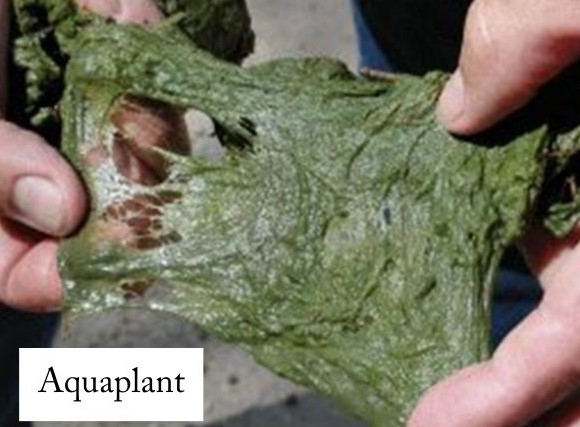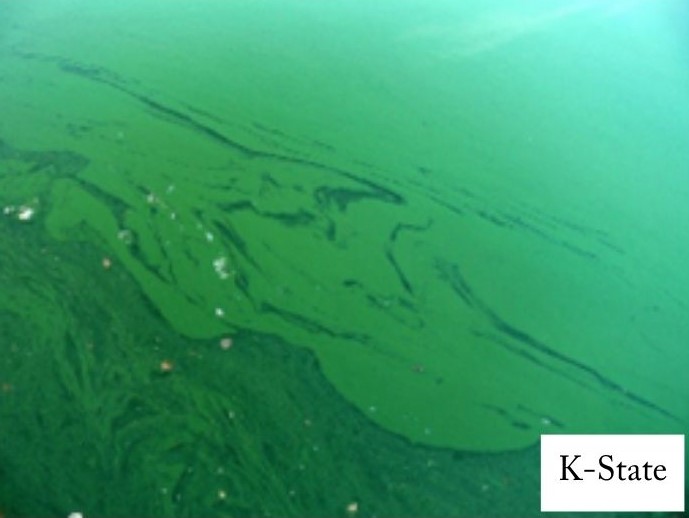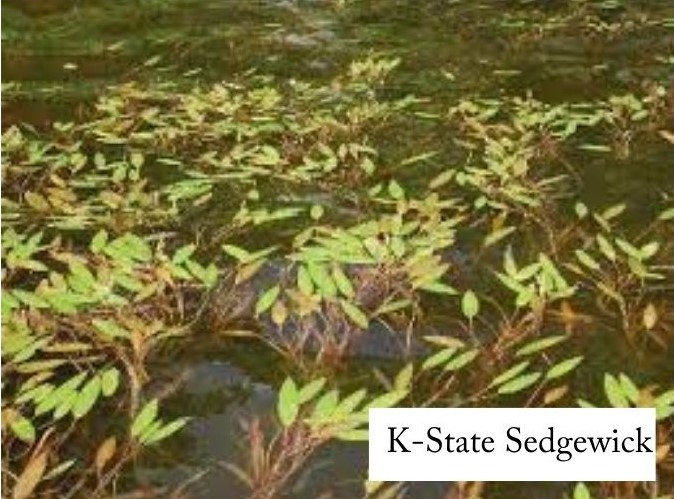What to do about that Green Pond out Back
Sharon Ashworth
Horticulture & Natural Resources
Extension Agent
As we head into the warmer months many ponds across the county will turn shades of green. Some shades of green are more

problematic than others – blue-green algae can be a problem, but duckweeds are an important food source for waterfowl and fish.
If you are concerned about the green growth in your pond, the first step is to correctly identify the algae or plants growing in your pond. There are basically three groups of aquatic organisms to be concerned with: algae, blue-green algae, and vascular plants. Algae (Aquaplant Photo) are photosynthetic organisms without roots, leaves, stems or flowers. Blue-green algae (K-State photo) are actually cyanobacteria, not algae. Vascular plants (K-State Sedgewick photo) have roots, stems, leaves, and flowers and can be submersed, free-floating, rooted floating, or emergent.
Aquatic vegetation grows and spreads in response to temperature, light, and nutrients. High nutrient runoff into shallow, warm ponds is the perfect recipe for explosions of aquatic vegetation.
For ponds dedicated to wildlife, a seasonal spread of duckweed (Lemna spp.) or pondweed (Potamogeton spp.) can provide food and cover for aquatic life. If, however, algae or a singular vascular plant species becomes dominant such that it crowds out other plant life or prevents the use of the pond for swimming and fishing, control measures may be warranted. Treatment may be recommended when aquatic vegetation covers more than 25% of the pond’s surface area.

Your control options include, first and foremost, prevention followed by mechanical, biological, and chemical methods. Preventing overgrowth of unwanted aquatic vegetation is primarily about keeping excess nutrients from reaching the pond. Water livestock away from the pond and maintain an un-mowed vegetative buffer, at least ten feet wide if possible, around the pond to capture nutrient run-off from fertilized fields and lawns. More expensive options include dredging ponds or installing aeration equipment. Mechanical methods include physical removal of aquatic vegetation or shading submersed vegetation with mesh fabric or dyes. Vascular plants may be controlled with grass carp (biological control), but this is not an option for algae. Algaecides and herbicides can be deployed as a last resort for control but proper identification

of nuisance vegetation is important. Do not chemically treat more than ¼ of the pond area at one time. Organisms that feed on decaying plant matter will use up the oxygen in a small pond if too much vegetation is killed at one time.
If the surface of your pond looks as if someone spilled a can of pea-green or brownish-red paint, it could be blue-green algae. If a stick stuck in the water comes up looking like it was painted, this might also suggest blue-green algae. Do not touch the pond water with bare skin if you suspect blue-green algae. Send in a pond water sample using the instructions linked below or call the Douglas County Extension office if you suspect blue-green algae.
If you have questions about the aquatic vegetation in your pond and how to manage it, please call the Douglas County Extension office.
Resources:
Aquatic Plants and Their Control
Identification and Management of Blue-green algae in Farm Ponds
